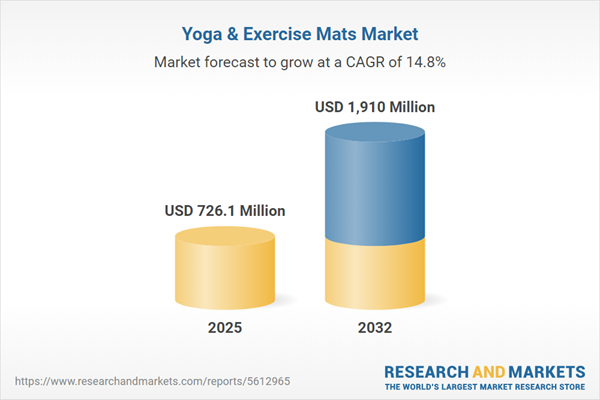Speak directly to the analyst to clarify any post sales queries you may have.
The global yoga and exercise mats market is evolving as organizations face changing wellness priorities, increasing compliance requirements, and rapid digital adoption. For leaders, adapting strategies in response to these drivers is crucial amid shifting industry dynamics and emerging risks.
Market Snapshot: Global Yoga and Exercise Mats Market Size, Growth, and Trends
The global yoga and exercise mats market is valued at USD 632.97 million in 2024, projected to reach USD 726.10 million by 2025 and USD 1.91 billion by 2032, with a CAGR of 14.82%. Market momentum arises from digital sales channel expansion, increased emphasis on wellness in daily life, and a rising commitment to sustainability across product development. Organizations are enhancing supply chain management, refining manufacturing processes, and updating operations to meet evolving regulatory expectations. As market trends become increasingly interdependent and dynamic, agile decision-making becomes a strategic imperative for industry leaders seeking to sustain growth and efficiency.
Scope & Segmentation: Key Drivers in the Yoga and Exercise Mats Market
Granular understanding of the yoga and exercise mats sector—covering product differentiation, end-user profiles, and distribution pathways—allows adopters to refine positioning and respond to specific market needs.
- Material Types: Industry offerings include cork, jute, PVC, rubber, and TPE mats. Companies balance functional requirements with environmental standards and regulatory obligations, shaping both compliance and brand perception among buyers concerned with sustainability.
- Application Areas: Products serve fitness centers, residential settings, hospitality venues, and outdoor locations. Each environment demands unique attributes in terms of portability, durability, and hygiene standards, prompting manufacturers to innovate features accordingly.
- Distribution Channels: Distribution models span brick-and-mortar retail, online marketplaces, specialty retailers, and direct-to-consumer e-commerce. These varied approaches improve consumer access and enable robust omnichannel growth strategies for brands.
- End User Profiles: The market targets individuals, households, fitness trainers, and instructors. Targeted product design and communication tactics enhance relevance and drive brand engagement across these segments.
- Thickness Options: Mats range from slim designs for portability to heavy-duty models intended for ergonomic support or intensive athletic performance, addressing use cases from rehabilitation to advanced sports.
- Geographic Regions: Diverse regional demands across the Americas, Europe, Middle East and Africa, and Asia-Pacific necessitate product customization, sensitivity to local compliance requirements, and adaptive supply chain solutions.
- Leading Companies: Key players including Lululemon Athletica Inc., Manduka LLC, JadeYoga LLC, Amazon.com Inc., Gaiam Inc., Decathlon S.A., adidas AG, Nike Inc., Onward Inc., and BalanceFrom International LLC. These organizations focus on sustainability and digital transformation to sharpen their market advantage and promote innovation.
Key Takeaways for Senior Decision-Makers
- Implementing responsible sourcing practices strengthens brand reputation and meets stakeholder and regulatory expectations for sustainability in procurement and supply chain oversight.
- Adopting integrated omnichannel strategies enhances market accessibility and supports consistent customer engagement across physical and digital platforms.
- Embedding technological solutions such as smart connectivity or digital tracking creates differentiated value for technology-aware consumer segments and brings actionable performance data.
- Prioritizing product portability and versatility supports consumer demand for solutions adaptable to home, commercial, and outdoor wellness settings.
- Forging partnerships with fitness sector professionals and technology providers accelerates market integration and ensures alignment with evolving wellness program requirements.
- Establishing effective compliance and risk management frameworks supports continuity across globally diverse supply chains, enabling swift adaptation to new regulations.
Tariff Impact: Sourcing and Regulatory Considerations
Recent United States tariff adjustments require industry participants to revise sourcing and logistics models. Focus areas include nearshoring, supplier diversification, and agile procurement to mitigate exposure and secure continuous supply. Enhanced collaboration with suppliers and expansion of private-label strategies help stakeholders maintain resilience and effectively navigate shifts in trade policies and compliance standards in the yoga and exercise mats market.
Methodology & Data Sources
This report leverages direct engagement with executive stakeholders, in-depth regulatory analysis, proprietary industry databases, and cited trade publications. Insights have been validated using supply chain performance audits to support reliable and actionable guidance for senior leaders.
Why This Yoga and Exercise Mats Report Matters
- Enables leaders to adapt quickly to changes in sustainability and compliance, ensuring resilient business models and informed strategic decision-making.
- Facilitates identification and management of emerging risks, providing actionable insights to drive sourcing innovation and lower compliance burdens.
- Supports optimal resource allocation and refined competitive positioning by delivering segmented, data-backed perspectives across the yoga and exercise mats industry.
Conclusion
Comprehensive, research-based insights assist executives in realigning organizational strategies, proactively addressing market challenges, and strengthening competitive positioning as industry dynamics shift.
Additional Product Information:
- Purchase of this report includes 1 year online access with quarterly updates.
- This report can be updated on request. Please contact our Customer Experience team using the Ask a Question widget on our website.
Table of Contents
3. Executive Summary
4. Market Overview
7. Cumulative Impact of Artificial Intelligence 2025
Companies Mentioned
The companies profiled in this Yoga & Exercise Mats market report include:- Lululemon Athletica Inc.
- Manduka, LLC
- JadeYoga, LLC
- Amazon.com, Inc.
- Gaiam, Inc.
- Decathlon S.A.
- adidas AG
- Nike, Inc.
- Onward, Inc.
- BalanceFrom International, LLC
Table Information
| Report Attribute | Details |
|---|---|
| No. of Pages | 189 |
| Published | October 2025 |
| Forecast Period | 2025 - 2032 |
| Estimated Market Value ( USD | $ 726.1 Million |
| Forecasted Market Value ( USD | $ 1910 Million |
| Compound Annual Growth Rate | 14.8% |
| Regions Covered | Global |
| No. of Companies Mentioned | 11 |









